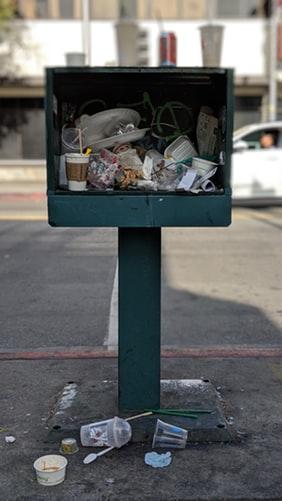Can Trash Be Art? This Minneapolis Artist's Art Is Trash
- July 3 2019
- 3 min read
Can Trash Be Art? This Minneapolis Artist's Art Is Trash

There's a small billboard on the grounds of the Minneapolis College of Art and Design (MCAD) Sculpture Garden. If you were to just glance at it, you might think it was an advertisement. Upon closer inspection, you'll discover that despite an instantly recognizable logo, it's not an advertisement at all. This billboard is actually a two sided display case. Created by Sean Connaughty, MCAD students and staff, and volunteers, it's filled with one day's worth of trash from Minnesota's Lake Hiawatha.
Let Custom Earth Promos help you reduce the amount of trash in your life.
This past Earth Day, about 375 volunteers helped Connaughty clean trash out of the lake. This resulted in a total of 18,879 items that were then sorted and categorized. Notation was taken of the corporation that produced the item.
The top four brands highlighted in Connaughty's cleanup were PepsiCo, Coca-Cola, McDonald's, and Mars, Inc. These are the four brands whose logos grace the four displays. They are also the four brands whose trash is stored inside them. McDonald's famous arches are made out of straws, Pepsi's circle is an empty Cheetos bag and bottles of Gatorade, and Mars' lettering is a sea of candy wrappers—mostly from their own company.
"I realize now that the question is and always has been: Who is responsible for the trash in Lake Hiawatha? Because no agency takes responsibility to clean up the trash at the lake. To me, the answer is the consumer, the producer, and our municipalities."
Minneapolis Artist Sean Connaughty
Connaughty lives only a few blocks away from the lake. It's a quiet place that would be beautiful if it weren't for all of the pollution. His art and his activism have been aimed at the garbage problem since 2015.
Lake Hiawatha is Lake Nokomis' less popular neighbor. It's smaller and has less visitors. However, the Minnesota Department of Natural Resources' Habitat Restoration Project includes native plants along the shoreline. This attracts all kinds of birds. But, it wasn't always a lake. Back in the early 1900s, Theodore Wirth, the then superintendent of Minneapolis Parks, suggested it be turned into a dry meadow, since it had subpar lake qualities. Instead, the lake was dredged in the 1930s, about the time the park board decided to build a golf course next to it.
Today, the golf course dumps millions of gallons of water into that lake each year. Lake Hiawatha is also the dumping ground for neighboring stormwater. With all of that stormwater comes the surrounding neighborhood's trash.
With no mitigation system in place to protect the lake, Connaughty started to clean it himself. He began picking up bags and bags of trash. He enlisted the help of friends and neighbors. so far, he's put together cleanups, published surveys of collected items, presented these items as part of gallery installations, and created public art awareness campaigns to reduce littering.
Litter less by replacing your water bottles and planting seed paper.
Connaughty has also organized, written letters, and spoken publicly at park board meetings; all in the hopes that something will be done about the amount of trash. He has been told that the cost to fix the problem would be $150,000. Reconfiguring the golf course, which is something the board is trying to do to lessen the amount of groundwater pumped, however, will cost $28.2 to $62 million!
"The mitigation has been tied to the fate of the golf course and held hostage because of the way negotiations have been set up."
Minneapolis Artist Sean Connaughty
The consumer is usually placed at fault for littering. With the MCAD displays, Connaughty is also placing blame on corporations and municipalities.
"One thing I noticed in talking to the community about trash is how easily it slid into a toxic narrative about blaming underserved communities. That was also part of my motivation for calling out other responsible parties."
Minneapolis Artist Sean Connaughty
A few months ago, Connaughty was asked to build this outdoor display at MCAD. As a 2018 McKnight Foundation award recipient, he was already slated to show his work in their indoor gallery. Inside, he placed trash in column shaped plexiglass display cases. His 2019 Lake Hiawatha Trash Survey, which breaks down collected items by type, is also part of the exhibition. The indoor show will finish on July 14, while the outdoor exhibit is here to stay.
The top four companies responded to Connaughty's project with disappointment and highlighted sustainability measures they are taking. These include recyclable packaging, trash and recycling receptacles, and partnerships with conservation groups.
The next step is to shift focus to the city and parks board.
"This is the fifth year of cleaning. We had hoped that a solution would be in place by now. That is part of the reason for upping the game a little bit."
Minneapolis Artist Sean Connaughty
Gain access to Orders, Tracking, Custom Options and Much More!